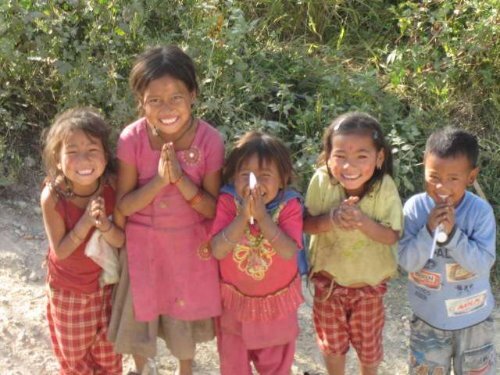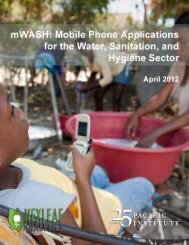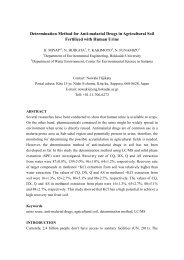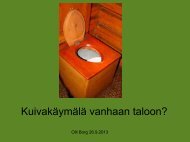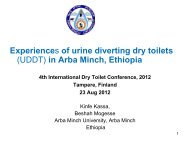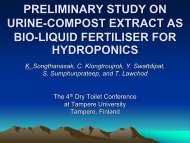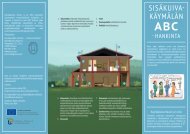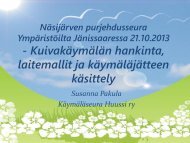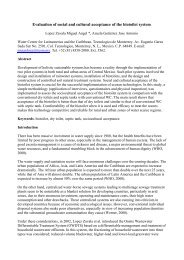PROMOTING ECOLOGICAL SANITATION IN A RURAL VILLAGE OF NEPAL
Yaba Laxmi Shrestha et al
Yaba Laxmi Shrestha et al
- No tags were found...
You also want an ePaper? Increase the reach of your titles
YUMPU automatically turns print PDFs into web optimized ePapers that Google loves.
ROLE <strong>OF</strong> ETHNIC WOMEN<br />
<strong>IN</strong><br />
<strong>PROMOT<strong>IN</strong>G</strong> <strong>ECOLOGICAL</strong><br />
<strong>SANITATION</strong> <strong>IN</strong> A <strong>RURAL</strong> <strong>VILLAGE</strong><br />
<strong>OF</strong> <strong>NEPAL</strong><br />
Yaba Laxmi Shrestha, Raimo Lilja<br />
CoDeF/KEMA<br />
Kathmandu , Nepal<br />
August 23,2012, DTC, Finland
<strong>NEPAL</strong><br />
• Officially named as "Federal Democratic Republic of Nepal"<br />
• Nepal, a developing country has diversified geography spread from Terai " flat plain<br />
" to Himalaya " highest peak in world", also rich in biodiversity and ethnicity having<br />
multicultural and multilingual societies.<br />
• Nepal has 26.6 million population at present that covers 39% of ethnic or<br />
indigenous groups . 31% of indigenous people are still below poverty line.<br />
• Situation of ethnic women is very poor in the country in many aspects like<br />
awareness, education, employment, opportunity, rights etc.<br />
• Their roles and responsibilities in many sectors such as agriculture, childcare,<br />
household, reproductive health etc. are very high in society but in practical, they are<br />
less prioritized and participatory.
COOPERATION BETWEEN <strong>NEPAL</strong> AND F<strong>IN</strong>LAND<br />
• Joint cooperation between Community Development Forum ( CoDeF), and Mikkeli<br />
Association for sustainable development (KEMA), Mikkeli,Finland with support of<br />
MFA,Finland<br />
• Launched the Project titled " Livelihood and Environmental Awareness project, ( LEAP)"<br />
• The project period is 3 years from 2010-2012<br />
• Project area: Devichour Village ( VDC), Lalitpur District
DEVICHOUR <strong>VILLAGE</strong>,<br />
LALITPUR<br />
Latitude 27° 32' to 27° 35' N Longitude 85° 14'60" -18'30" E; Highest elevation : 5000 m
OBJECTIVES<br />
Main Objective:<br />
• To improve livelihood of people in Devichaur<br />
through environment awareness program in<br />
sustainable integrated approach.<br />
Specific objectives:<br />
– To develop women institution at local level, their<br />
empowerment through capacity building and<br />
mobilization<br />
– To increase awareness raising and improve health,<br />
hygiene and sanitation<br />
– To increase income generation through using natural<br />
resources at local level
DEVICHOUR <strong>VILLAGE</strong><br />
• Devichaur is one of 41 villages of<br />
Lalitpur district<br />
• Total households - 524 with<br />
population - 2733<br />
• 49% of total population are female<br />
• 80% of Total population is Tamang,<br />
ethnic community of Nepal<br />
• Tamang, ancient Tibetan origin and<br />
culture<br />
• Cousin marriage system, polygamy<br />
( commonly having 2 wives)<br />
• Major profession are agriculture,<br />
livestock farming and labor work<br />
• The literacy rate is only 43.3 %<br />
(male - 24.5 %, female - 18.8 %)
MAJOR ENVIRONMENTAL SITUATION<br />
• 97% of the families access to drinking water from ground water source but it is<br />
unsafe<br />
• Toilet coverage in the community is 41 %.<br />
• Rest of people, 88% defecate nearby forest and another 12% use open field.<br />
• 60% of households used soap for washing hands and rest by only water or ash<br />
after defecation.<br />
• Most common diseases - diarrhea/dysentery, Typhoid, skin diseases , Jaundice,<br />
cholera etc. related to unsafe drinking water and poor sanitation
MAJOR STRATEGY<br />
Development of<br />
women institution and<br />
strengthening of their<br />
capacity<br />
Identification of<br />
problems and needs,<br />
preparation of Action<br />
Plan with participatory<br />
approach<br />
Implementation of<br />
activities with<br />
community<br />
initiative<br />
Increase level of access<br />
of women on local<br />
resource mobilization<br />
and income generation<br />
• Introduction of<br />
project to local<br />
government<br />
organization and<br />
stakeholders,<br />
• Identification of poor<br />
communities<br />
• Women group<br />
formation<br />
• Saving and credit of<br />
group<br />
• Social mobilization<br />
• Discussion and<br />
sensitization of<br />
problems and<br />
needs in monthly<br />
meeting of<br />
women group<br />
• Participating<br />
women group in<br />
Action Plan<br />
• Awareness raising<br />
• Training and capacity<br />
building<br />
• Construction of toilet<br />
• Technical guidance<br />
• Materials distribution<br />
• Capacity building on<br />
FHCV for improving<br />
health and hygiene<br />
• Hand washing<br />
program<br />
• Drinking water quality<br />
improvement<br />
• Identification of<br />
local natural<br />
resources<br />
• Training on Organic<br />
vegetable farming<br />
and use of urine<br />
• training on Nontimber<br />
forest<br />
plantation<br />
• Develop market<br />
linkage for products<br />
• extension of foot<br />
trail n its<br />
maintenance
IMPLEMENTATION PROCESS<br />
1.Women institution development<br />
2. Sensitization of problems on Health and Sanitation<br />
3. Awareness raising campaign<br />
4. Training and Study Tour
IMPLEMENTATION PROCESS<br />
5. Planning<br />
6. Construction of ECOSAN toilet<br />
7. Capacity building training and study tour on use of urine and organic<br />
farming<br />
8. Awareness raising on preventive measures for improvement of<br />
health and sanitation
<strong>ECOLOGICAL</strong> <strong>SANITATION</strong> TOILET<br />
• Community of Devichour<br />
prefer and constructed Urine<br />
diverting ecological sanitation<br />
(ECOSAN) toilets<br />
• Constructed about 100<br />
Households ECOSAN toilet in<br />
Devichour and still more<br />
demands<br />
• Constructed 2 ECOSAN toilet<br />
in secondary school of<br />
Devichour<br />
• Altogether 600 population<br />
and 750 students benefitted
CASTE WISE DISTRIBUTION <strong>OF</strong><br />
<strong>ECOLOGICAL</strong> <strong>SANITATION</strong> TOILET<br />
14%<br />
1%<br />
Tamang Brahman Dalit<br />
85%
USE <strong>OF</strong> UR<strong>IN</strong>E AS ORGANIC FERTILIZER<br />
• The LEAP provide training and<br />
field tour for all toilet users on<br />
using urine as organic fertilizers<br />
• 80% of ECOSAN toilet users used<br />
urine as organic fertilizers.<br />
• 40% used urine directly as<br />
fertilizers mixing with two third<br />
amount of water while using<br />
• 60% used urine first in compost<br />
pit and then after time being<br />
used compost in the agriculture<br />
field<br />
• 20% of ECOSAN toilet users still<br />
hesitate to use urine as organic<br />
fertilizers
IMPROVEMENT <strong>OF</strong> HEALTH AND HYGIENE<br />
Female community heath volunteers (FCHV) along with women groups<br />
organize various awareness raising and provide basic health services<br />
to community on :<br />
• Reproductive and child health care<br />
• Awareness raising on health impact of poor sanitation<br />
• Preventive measures from water borne diseases<br />
• First aid services<br />
• Support to promote mobile health clinic centers
Improvement of Drinking water quality<br />
• Formation of Drinking Water users group committee<br />
• LEAP initiated 6 drinking water improvement<br />
schemes which are all lead by women<br />
• Organized training on water quality test and safe<br />
drinking water to the women groups
PROMOTION <strong>OF</strong> <strong>IN</strong>COME GENERATION ACTIVITIES US<strong>IN</strong>G<br />
LOCAL NATURAL RESOURCES<br />
•Mobilization of women group saving in<br />
income generation activities providing<br />
microloan to their members in various<br />
sectors like livestock farming, poultry<br />
farming, tailoring etc.<br />
•capacity building training for women<br />
group members on cash crop plantation,<br />
herbal plantation, varieties of vegetables<br />
farming, fruit plantation, vegetable<br />
marketing management, Swing and<br />
cutting training , organic farming training<br />
etc.<br />
•Distribution of various seeds and sapling.<br />
The groups generate fund selling those to<br />
their members in subsidy price.<br />
•Distribution of Bee-hive to farmers for<br />
honey production<br />
•Training and Production of Briquette (<br />
smokeless coal)
• Hand washing is a basic<br />
and preventive measures<br />
of improving sanitation.<br />
• Female community<br />
health volunteers<br />
organized household<br />
campaigns in the<br />
community for hand<br />
washing campaign.<br />
• Hand washing practices<br />
to school students<br />
through school child club.<br />
HAND WASH<strong>IN</strong>G
Integrated community development<br />
• Repair and maintenance of<br />
green roads Voluntarily by<br />
various women groups in<br />
different area. within 2010-2012,<br />
they have repaired about 25 kms<br />
• Construction of Improve<br />
(Smokeless) cooking stoves<br />
• School environment awareness<br />
programs and formation of<br />
children nature club<br />
• Active participation of women<br />
representatives in village<br />
development planning<br />
• Celebration of World<br />
Environment Day, Women Day,<br />
Teej and Tihar festival<br />
• Plantation in the community<br />
forest
CHALLENGE<br />
• Initially difficulties in motivation of<br />
community in construction of<br />
toilet<br />
• Hesitate to use urine as organic<br />
fertilizers<br />
• Difficult to reduce use of pesticides<br />
and chemical fertilizers among<br />
professional vegetables farmers<br />
• Difficult to change behavior of<br />
social leaders in compare to<br />
general community.<br />
• Difficult to promote Dry Ecological<br />
sanitation toilet.<br />
• Reaching the ultra poor family<br />
• Technical maintenance from HH<br />
level
• Improvement of sanitation<br />
and Community<br />
development can be<br />
successfully implemented<br />
in women leadership<br />
• Difficult to bring up ultra<br />
poor people into<br />
development mainstream<br />
• Indigenous technology<br />
should not be avoided but<br />
it needs to integrate in the<br />
development activities.<br />
LEARN<strong>IN</strong>G


